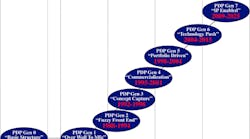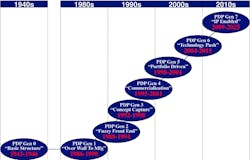By the early 1980s, for example, it became clear the assembly-line method of design and development was becoming obsolete. Marketing departments could no longer study a proposed new product for a few months then just send a sheet of specs to engineering. And engineering could no longer work independently and then throw the design over the wall to operations with subsequent changes to the design based on feedback from manufacturing. There was simply not enough time for that any more.
By the late 1980s, design constraints and considerations in engineering such as Design for Manufacturing (DFM) were well along. These helped put the spotlight on the idea of better understanding customer needs and requirements. Good companies realized there was not enough time to miss and misinterpret customer requirements and then redesign products to correct them.
Next, products were being tossed over the wall to sales. However, too many companies had months pass with little revenue while the sales force prepared the market and themselves for the sales cycle. Soon, new-product development had a commercialization phase and team and management postlaunch reviews. To help companies handle all the new steps and phases of product development, process-management software emerged. Companies that were behind could purchase it and quickly become competitive again.
Companies became about equal in their ability to turn ideas into products, concept to customer. So what would be the next opportunity for competitive advantage? Management realized that companies with the strongest portfolio of concepts and product ideas would have a leg up. So portfolio management took off. Like process-management software, portfolio-management software was soon available, and laggard companies could quickly become competitive again.
You can train employees in following a process, using software, applying six-sigma, analyzing for lean opportunities, and in employing other deterministic techniques. It is an entirely different matter to teach innovation and invention. And invention is much harder, perhaps impossible, to capture in software. This is where we are today. Companies are working diligently to create an innovative workforce so products they release will be more appealing and provide customers more value than competitive offerings.
Because the ability to gather requirements from the marketplace is about equal across companies, the critical competitive advantage will be inventing technologies and capabilities that cannot be gleaned by market research and focus groups. The great wave of “Tech Push” is upon us.
The creation of proprietary capabilities, in this day and age where just about everything can be reverse engineered and quickly copied, necessitates the need for protecting intellectual property (IP). In years ahead, IP will be a key competitive differentiator. Laggard companies will have to compensate inventive companies for IP that lets it turn out competitive products. IP will become a readily monetized commodity. “Tech Push” and “IP Enabled” product development will challenge designers and developers throughout this decade and beyond.
Bradford L. Goldense, NPDP, CMfgE, CPIM, CCP, president of Goldense Group Inc. (GGI) (www.goldensegroupinc.com), has advised over 300 manufacturing companies in product management, R&D, engineering, product development, and metrics on four continents. GGI is a consulting, market research, and executive education firm founded in 1986.
Subsequent writings in this column will expand on the lessons-learned of where
we have been, and will offer views on what the future holds for product design.


